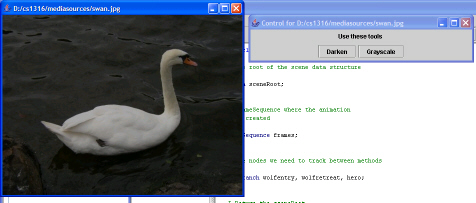









  |
| |||||||||
        |
| All homework are due by 10 pm on the due date! |
| Extra Credit: Up to 10 points extra credit if one of the parts is generated algorithmically. If you just have random notes, you'll get 1 point. If you have random notes that match duration (i.e., the random part doesn't go longer than the other parts), you get 5 points. If your notes are actually sonorous (not dischordant) with the rest of the piece and you have a mix of note durations (but still doesn't go longer), you can get up to 10 points. |
| For +5 points extra credit, use the SongPart class and create your song with more than one part and instrument. |
| Extra Credit 5 points: Make some of your methods work with PositionedSceneElement, and use them to create a long pattern of smallish images via weaving and repeating, in order to create an interesting tiling on a long picture (e.g., at least 1000 pixels long). Say "dog, dog, house, dog, dog, tree–repeat." Show a fifth picture of some long picture with the tiling pattern appearing on it. |
| THERE MUST BE AT LEAST 20 FRAMES IN YOUR ANIMATION. |
| You must write HW7 using Pair Programming. Announce your pair at Student187. Not working in a pair is a 5% score penalty (i.e., you lose five points from the start.) |
Welcome to DrJava.
> PictureTool pt = new PictureTool("D:/cs1316/mediasources/swan.jpg");

Hint: If you need to convert the String from a text field into a Double (with a floating point, like for scaling), you can use Double.parseDouble(String) like this:
> Double.parseDouble("3.45")
3.45
|
| You must write HW8 using Pair Programming. Announce your pair at Student187. Not working in a pair is a 5% score penalty (i.e., you lose five points from the start.) |
| Overcrowding | Maybe there are more people to start with, or it takes more near neighbors to convince someone that they're overcrowded, or more timesteps of crowded conditions to convince them to move |
| Crop failures | What if crop failures were more common, or it took multiple consecutive crop failures to convince someone to emigrate. |
| Travel | What if people didn't die on the trip over, or if it took longer |
| Movement | What if people moved more often, or further, in either America or Europe. |
| Disease | In America, it was more likely crowded conditions that led to disease. What if people moved like they do in Europe, and they all came ashore at the same 2 or 3 spots, and then the incidence of disease was dependent on the number of people around you? |
| You must write HW9 using Pair Programming. Announce your pair at Student187. Not working in a pair is a 5% score penalty (i.e., you lose five points from the start.) |
| EXTRA CREDIT: There is no requirement to have different types of villagers, but I'll offer up to 10 points extra credit for having three or more types (e.g., maybe 5 points for two types.) One type of villager might look younger and move faster, another might look older and move slower. And maybe there's a maniacal kind that keeps heading for the obstacles! Mark Guzdial |